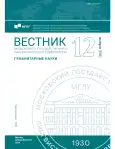COMPOUNDING AND ITS ROLE IN OFFICIAL-DOCUMENTARY TEXTS IN SWEDISH
- Авторлар: Matytsina I.V.1
-
Мекемелер:
- Lomonosov Moscow State University
- Шығарылым: № 12(893) (2024)
- Беттер: 40-46
- Бөлім: Linguistics
- URL: https://bakhtiniada.ru/2542-2197/article/view/291713
- ID: 291713
Дәйексөз келтіру
Толық мәтін
Аннотация
The aim of the research is to determine the role of compound words in official-documentary texts by analysing utterances that contain them. The study material was obtained through systematic sampling from a Swedish language corpus and international legal documents, using a descriptive method as well as methods of structural and semantic analysis and contextual analysis. The findings indicate that the use of compound words reinforces the nominal character of official-documentary texts, increases their complexity index, and enhances the compression, compactness and static nature of the statements. Compound words are a crucial resource and a distinctive feature of formal language.
Негізгі сөздер
Авторлар туралы
Irina Matytsina
Lomonosov Moscow State University
Хат алмасуға жауапты Автор.
Email: imatits@gmail.com
PhD in Philology, Associate Professor at the German and Celtic philology chair Faculty of Philology, Lomonosov Moscow State University
РесейӘдебиет тізімі
- Belov, S. A., Gulida, V. B. (2019). The language of legal documents: difficulties in understanding. Acta Linguistica Petropolitana, XV-1, 56–104. St.Petersburg: The Institute for Linguistic Studies of the Russian Academy of Sciences. https://alp.iling.spb.ru/static/alp_XV_1/titlepage.pdf (date of access: 24.08.2023). (In Russ.)
- Maslova-Lashanskaya, S. S. (2011). Leksikologiya shvedskogo yazyka = Lexicology of the Swedish language. Study guide. 2nd ed., rev. and suppl. St.Petersburg: Faculty of Philology. St.Petersburg University. (In Russ.)
- Maslova-Lashanskaya, S. S. (1991). O sintaksicheskoj funkcii slovoobrazovaniya v shvedskom yazyke = On the syntactic function of word formation in the Swedish language. Skandinavskaya filologiya. Scandinavica, V, 25–35. Leningrad: Izdatel’stvo Leningradskogo universiteta. (In Russ).
- Nikulicheva, D. B. (2000). Sintagmaticheskie otnosheniya v kontinental’nykh skandinavskikh yazykakh = Syntagmatic relations in continental Scandinavian languages. Moscow, St.Petersburg, 2000. (In Russ).
- Kukushkina, E. A. (2007). Tipologija kompozitov v jerzjanskom i nemeckom jazykah = Typology of composites in Erzyan and German languages: PhD in Philology. Saransk. http://www.dslib.net/jazyki-rosii/tipologija-kompozitov-v-jerzjanskom-i-nemeckom-jazykah.html (date of access: 22.05.2023).
- Zhiltsova, E. L. (2023). The Newest Swedish Vocabulary: Theme Groups, Origin, Word-Formation Features. Vestnik of Moscow State Linguistic University. Humanities, 4(872), 35–41. (In Russ).
- Chekalina, E. M (2023). Imennye kompozity kak hudozhestvennoe sredstvo v poezii Edit Syodergran i ih otrazhenie v russkom perevode = Name composites as an artistic means in the poetry of Edith Södergran and their reflection in Russian translation. In Yarmakeev, I. E., Tarasova, F. H. (Eds.), Sovremennaya lingvistika: ot teorii k praktike (vol. 2, pp. 197–201): III Kazanskij mezhdunarodnyj lingvisticheskij sammit (Kazan’, 2022, November 14–19): in 3 vols. Kazan: Izdatel’stvo Kazanskogo universiteta Kazan’. (In Russ).
- Savickij, V. M., Kulaeva, O. A. (2004). Koncepciya lingvisticheskogo kontinuuma. Tekst = Linguistic continuum concept. Text. Samara: NTC. (In Russ).
- Björnsson, C.-H. (1968). Läsbarhet. Stockholm: Liber.
- Hellspong, L., Ledin, P. (1997). Vägar genom texten: handbok i brukstextanalys. Lund: Studentlitteratur, 1997.
- Svensson, E. (2013). Metaforer och metonymier i myndighetstexter. En studie av oetablerat bildspråk i Försäkringskassans broschyrer, Umeå universitet. https://www.sprakinstitutet.fi/files/4968/Klarsprak_i_kommunen. pdf (date of access: 29.06.2012).
Қосымша файлдар










